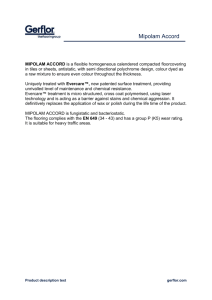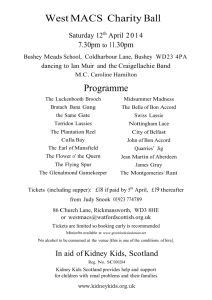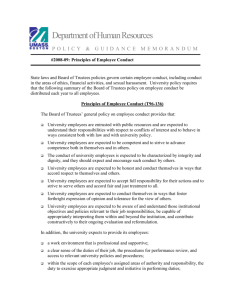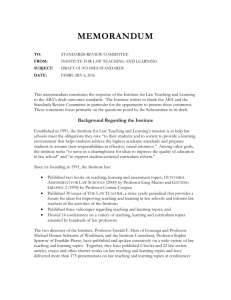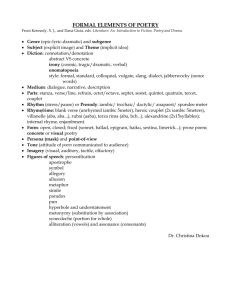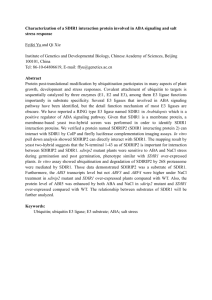exhibit a-1
advertisement
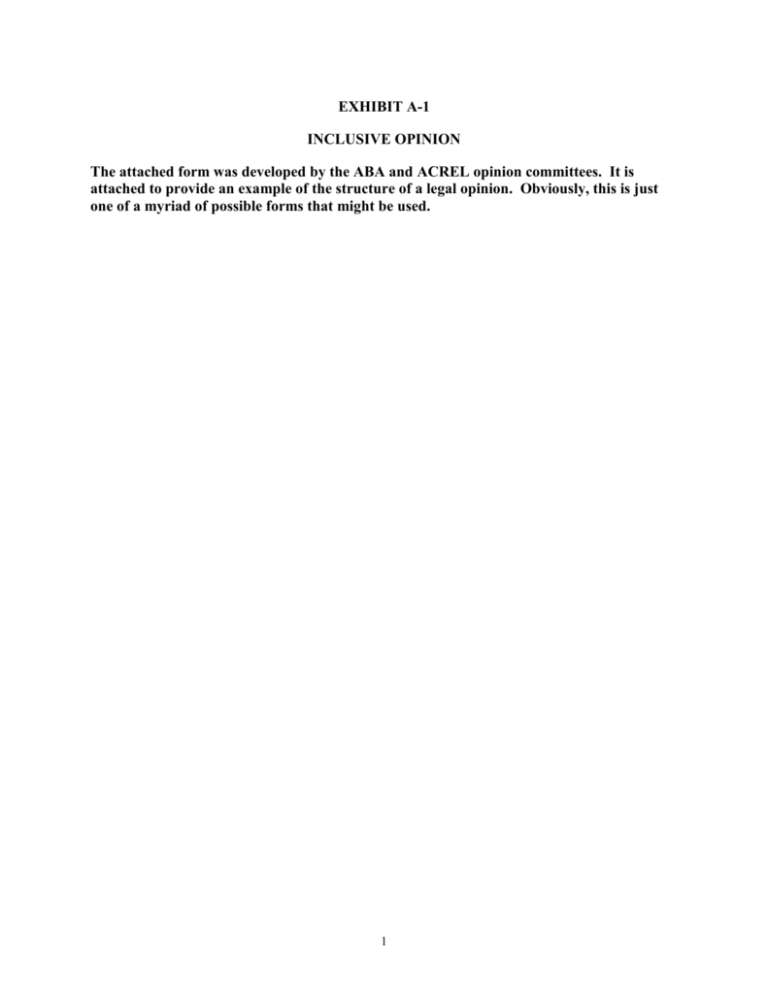
EXHIBIT A-1 INCLUSIVE OPINION The attached form was developed by the ABA and ACREL opinion committees. It is attached to provide an example of the structure of a legal opinion. Obviously, this is just one of a myriad of possible forms that might be used. 1 Inclusive Real Estate Secured Transaction Opinion In Which are Incorporated the Principal Concepts of The ABA Section of Business Law Legal Opinion Accord and The ABA Section of Real Property, Probate and Trust Law and The American College of Real Estate Lawyers Report on Adaptation of the Legal Opinion Accord A REPORT OF THE JOINT ABA/ACREL COMMITTEE COMPRISING: THE AMERICAN BAR ASSOCIATION, SECTION OF REAL PROPERTY, PROBATE AND TRUST LAW, COMMITTEE ON LEGAL OPINIONS IN REAL ESTATE TRANSACTIONS, SUBCOMMITTEE ON CREATION OF AN INCLUSIVE OPINION: David L. Miller, Washington, D.C., Co-Chair; Mark R. Spradling, Houston, Texas, Co-Chair; Benson Joel Barr, Southfield, Michigan; Gurdon H. Buck, Hartford, Connecticut; Frederic W. Clark, Philadelphia, Pennsylvania; Dianne S. Coscarelli, Cleveland, Ohio; William B. Dunn, Detroit, Michigan; Kenneth P. Ezell, Jr., Nashville, Tennessee; Timothy W. Grooms, Little Rock, Arkansas; Karl B. Holtzschue, New York, New York; Raymond Iwamoto, Honolulu, Hawaii; Thelma Rivera-Miranda, Hato Rey, Puerto Rico; Robert A. Thompson, San Francisco, California; and William L. Thompson, Jacksonville, Florida; and AMERICAN COLLEGE OF REAL ESTATE LAWYERS ATTORNEYS’ OPINIONS COMMITTEE: Edward J. Levin, Baltimore, Maryland, Chair; Portia O. Morrison, Chicago, Illinois, Co-Vice Chair; Charles S. Sokoloff, Smithfield, Rhode Island, Co-Vice Chair; Robert A. Thompson, San Francisco, California, Co-Vice Chair; Charles H. Andresen, Duluth, Minnesota; David C. Auten, Philadelphia, Pennsylvania; Drake M. Batchelder, Ft. Lauderdale, Florida; Wm. Terry Bray, Austin, Texas; Stephen A. Bromberg, Birmingham, Michigan; Gurdon H. Buck, Hartford, Connecticut; Mert F. Buckley, Wichita, Kansas; James A. Cole, Baltimore, Maryland; William B. Dunn, Detroit, Michigan; A. James Elliott, Atlanta, Georgia; K. Gregory Erwin, Houston, Texas; Howard M. Feuerstein, Portland, Oregon; Joseph Finley, Minneapolis, Minnesota; W. Bebb Francis, III, San Antonio, Texas; Catherine T. Goldberg, Albuquerque, New Mexico; Martin Gottlieb, Boston, Massachusetts; Donald J. Gralen, Chicago, Illinois; Samuel F. Hatcher, Atlanta, Georgia; Robert O. Hetlage, St. Louis, Missouri; Karl B. Holtzschue, New York, New York; John B. Hood, Rochester, New York; Morris C. Kellett, Philadelphia, Pennsylvania; Henry M. Kittleson, Lakeland, Florida; Daniel L. Klein, Wilmington, Delaware; Michael Levin, Hartford, Connecticut; Timothy Martin, Louisville, Kentucky; Thomas A. Mason, Cleveland, Ohio; William L. McCown, Milwaukee, Wisconsin; K.C. McDaniel, New York, New York; Russell A. McNair, Jr., Detroit, Michigan; O’Malley M. Miller, Los Angeles, California; Allan E. Mulligan, Bloomington, Minnesota; J. Fred Powell, Birmingham, Alabama; Laurence G. Preble, New York, New York; Myrna Putziger, Boston, Massachusetts; Susan M. Reid, San Francisco, California; Richard L. Reppert, Cleveland, Ohio; Leon J. Reymond, Jr., New Orleans, Louisiana; Thomas G. Roberts, Los Angeles, California; James Rosenbloom, Chicago, Illinois; Stanley M. Samuels, Portland, Oregon; Richard W. Scarritt, Kansas City, Missouri; Leopold Z. Sher, New Orleans, Louisiana; David S. Sidor, Columbus, Ohio; Gary A. Taback, Southfield, Michigan; Courtland Traver, McLean, Virginia; Ira J. Waldman, Los Angeles, California; James H. Wallenstein, Dallas, Texas; James G. Wheeler, Jr., St. Johnsbury, Vermont; and Jeffrey P. Zucker, Las Vegas, Nevada. 2 Inclusive Real Estate Secured Transaction Opinion I. INTRODUCTION The ABA Legal Opinion Accord and the report of which it is a part1 are impressive in many ways, and have received some acceptance, but they have yet to become the nationwide standard that their authors had hoped. Particularly given the availability of state bar association reports in many jurisdictions, practitioners have evidenced mixed responses to learning a new body of legal opinion practices. This is at least in part because the Accord looks and perhaps is difficult to master and the Accord omits coverage of many substantive areas common to legal opinions in real estate transactions. To address at least the latter issue, a joint committee of the ABA and the American College of Real Estate Lawyers published a report adapting the Accord for loans secured by real property.2 But, if the Accord is difficult to master, it is even a more challenging task to achieve a clear and comprehensive knowledge of how the Accord works as supplemented—and modified—by the ABA/ACREL Report. The principal goal of this report is to facilitate understanding of the ABA Business Law Report (including the Accord) and the ABA/ACREL Report (collectively, the “Opinion Reports”). II. FALSE BREVITY One of the fundamental approaches of the Accord, which the ABA/ACREL Report also follows, is that each legal opinion letter that is to be governed by the Accord (or the Accord as modified and supplemented by the ABA/ACREL Report) will incorporate those documents by reference. This would result in very short opinion letters, and in the ability to quickly check any variations between a given opinion letter and the Accord or the ABA/ACREL Report. While brevity undoubtedly is a virtue (and is the soul of wit3), this brevity is only skin deep. Behind the short-form of Accord opinion lies a complex set of code-like and specific interpretive rules that have no history of interpretation by courts. No attorney will or should give or receive an opinion that incorporates the Accord or the ABA/ACREL Report without being sufficiently comfortable that he or she understands those documents and how they are likely to be interpreted in the future. Few have achieved this level of comfort. 1 The “Accord” is part of the Third-Party Legal Opinion Report, including the Legal Opinion Accord, of the Section of Business Law, American Bar Association, 47 BUS. LAW. 167 (1991) (reprinted in 29 REAL PROP. PROB. & TR. J. 487 (1994)) (referred to below as the “ABA Business Law Report”). 2 Report on Adaptation of the Legal Opinion Accord of the Section of Business Law of the American Bar Association for Real Estate Secured Transactions of the Section of Real Property, Probate and Trust Law of the American Bar Association and the American College of Real Estate Lawyers, 29 REAL PROP. PROB. & TR. J. 569 (1994) (referred to below as the “ABA/ACREL Report”). 3 W. Shakespeare, Hamlet, Act 2, Scene 1, line 78 (1601). 3 III. INCLUSIVE OPINION FORM Despite these difficulties, we believe that the goals of the Opinion Reports are worth pursuing and that these publications are worth understanding. The Joint Committee believes that it would enhance the understanding of the Opinion Reports if we could show how an opinion might look if it included the principal concepts contained in these two published opinion letter reports, without specifically referring to them; that is, a kind of one stop shopping. The form of opinion letter which follows this brief introduction attempts to do just that for real estate loans, the most common kind of real estate transactions giving rise to third-party legal opinion letters. This form of opinion letter is intended primarily to serve an educational purpose, not to serve as a model. We also recognize that this form of opinion is not the only way to set forth the positions stated in the Opinion Reports. This form of opinion letter perhaps gives rise to the opposite of the risk of false brevity, the risk of false comprehensiveness; nor does this form expressly cover each principle stated in the Opinion Reports. Finally, both the Opinion Reports permit private ordering between the parties to each transaction, the use of which would result in changes to the opinions, assumptions and other qualifications in this form. The Opinion Reports both are useful and constitute significant progress toward achievement of a national consensus for real estate opinion practice. We intend through this “inclusive” form of opinion letter to enhance understanding of the meaning of the Opinion Reports. 4
